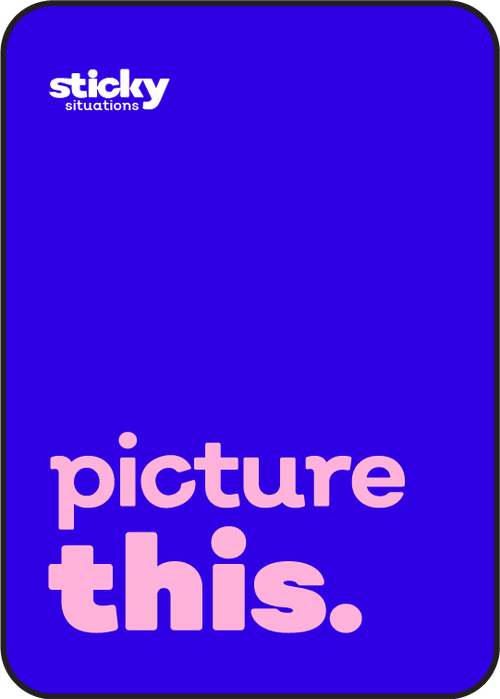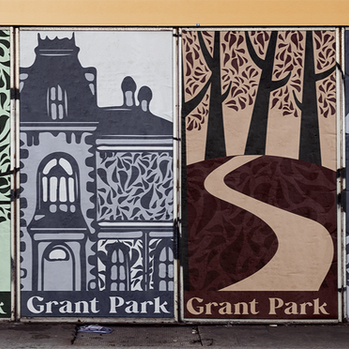
Sticky Situations
the social awkwardness survival game
Social awkwardness and social anxiety can cause you to feel uncomfortable and out of place in social situations - but here's the thing, some social situations are pretty much...unavoidable, and we also WANT to get better at navigating a social situation with ease and comfort.
Sticky situations is a game designed BY the socially awkward (me!), FOR the socially awkward. It isn't a cure, but I promise a lot of good conversations, and a LOT of fun.
The challenge
Winter 2024
Completed
identity / game design / packaging design
Skills Used
is the intense fear of being judged, negatively evaluated, or rejected in a (sticky) social situation.
Social Anxiety

About Social Anxiety
Social awkwardness and social anxiety are vastly underrated on the spectrum on mental health.
The defining feature of social anxiety disorder is intense anxiety or fear of being judged, negatively evaluated, or rejected in a social or performance situation. People with social anxiety disorder may worry about acting or appearing visibly anxious (e.g., blushing, stumbling over words), or being viewed as stupid, awkward, or boring. As a result, they often avoid social or performance situations, and when a situation cannot be avoided, they experience significant anxiety and distress.
Studies also indicate younger individuals are disproportionately affected by social anxiety, with prevalence rates at around 10% by the end of adolescence [22–24], with 90% of cases occurring by age 23.
I consider myself to be pretty socially awkward, but I still had to educate myself, y'know?


This research is endless
My research started from - well, me. I noted down how I reacted in sticky social situations, and noticed which scenarios were likely to trigger my own response. I interviewed friends and family, and then began to cast a wider net.
The reddit forum r/SocialAnxiety proved to be a super helpful resource. I began to collect stories of people describing their own experiences and what helped them (or what didn't). I began to see patterns in stories and started to make groups of related social scenarios that triggered social anxiety.
Early on, it became clear to me that while many people's stories carried an air of hopelessness about them, there was also a determination to keep trying. People were using the forum to ask others what helped, and sharing their own success stories.
I realized that people on the spectrum of social anxiety truly do want to get better at navigating a social situation with ease and comfort.
Social anxiety manifests in different ways, but there's one common factor:
From my research, I realized that
the spiral.

The spiral is REAL, I assure you.
One particular conversation with my (extremely socially anxious friend) stuck with me. On being forced to wait for me at a restaurant till I arrived (sorry, Devika), she began to text me frantically, asking me to get there as quick as I can. She had ordered drinks for two people, and she began to wonder aloud if the waiters and waitresses at the cafe were judging her for ordering multiple drinks while sitting alone. What if they thought she didn't have any friends? What if they thought she was an alcoholic?
That's when it truly sunk in for me that while our social awkwardness might manifest in totally different ways, we all had one thing in common.
Whenever we found ourselves in a sticky social situation, we tended to jump to the worst-case scenario possible without reason. We began to spiral.

I wanted to show that for every worst-case scenario our minds jump to, there's always a way to make the best of it.
(Even if it's not one you expect.)
Social awkwardness and anxiety isn't something you can CURE. But still,



The primary palette
I was heavily inspired by quotes from user stories that described social anxiety as drowning, and I drew my color palette from there: a deep blue to depict the feeling of drowning, an orange that mimic buoys, and a calm white to denote solutions.
Social anxiety can get triggered in all kinds of sticky social situations.
(And I tried my best to capture them all.)



Grouping sticky social situations
During my research, I came across tons of interesting stories and experiences people had during which their social anxiety was triggered. I began to note similarities, find patterns, and then form groups of them. These groups would eventually form another vital aspect of the game, and determined my secondary color palette.
Based on my research from online forums and talking to my friends, family, and other acquaintances, I identified specific scenarios that triggered social anxiety spirals, and then categorized them into the following:
-
social situations involving professionals (giving presentations, talking to figures of authority, giving/taking an interview etc)
-
social situations involving friends and family (dealing with fallout, interacting at parties/meet-ups, catching up etc)
-
social situations involving strangers (joining a conversation, making small talk, breaking the ice etc)
-
So the least I could do was make it a lil' fun, right?
This is an experience that's designed to simulate the discomfort you feel in a sticky social situation.

the social awkwardness survival game

Naming woes
The name of the game went through several variations (What's the worst that could happen / Worst-case scenario / Never gonna happen) before I finally settled on Sticky situations.
For my logo, I chose the font Nutmeg in a heavier weight, since it seemed to accurately capture the heaviness of being in a sticky social situation. I used Wavehaus as my primary font for the cards themselves, and took inspiration from the tilted axis of its lowercase 'e' to add some whimsy to my logo itself, a style that carries forward to the card backs.

Here's what I found out when I observed my test groups play the game.
Testing the game had me cycling through several versions, but here's what I noticed with the one that finally stuck:
-
It started a conversation about social anxiety, which is a largely underestimated and lesser-talked-about aspect of mental health. I want to invite discourse, but also keep it lighthearted and FUN.
-
It gets people on the spectrum of social anxiety used to the discomforts of being in a social situation. I had participants actively cringing and relating to the sticky social situations they were put in during the game.
-
It gets people WITHOUT social anxiety to put themselves in shoes they might not have considered before.
-
The game is FUN. Like, for real.
-
Get yourself unstuck from these sticky situations!
(Well, these are the cards you've been dealt. Are they the best ones for the sticky social situation you're stuck in?


















Sticky Situations, the social awkwardness survival game.
Let's play a round of

Here's what I found out when I observed my test groups play the game.
Testing the game had me cycling through several versions, but here's what I noticed with the one that finally stuck:
-
It started a conversation about social anxiety, which is a largely underestimated and lesser-talked-about aspect of mental health. I want to invite discourse, but also keep it lighthearted and FUN.
-
It gets people on the spectrum of social anxiety used to the discomforts of being in a social situation. I had participants actively cringing and relating to the sticky social situations they were put in during the game.
-
It gets people WITHOUT social anxiety to put themselves in shoes they might not have considered before.
-
The game is FUN. Like, for real.
-

Your game comes with 3 kinds of cards:

Make the best of 3 modes of gameplay!

When you've got social anxiety, there might be times you want to be ALONE. Well, we've got you covered for just that!
Sticky Situations in solo mode is more of a matching exercise, but it's still FUN, we can assure you of that. Pick out a sticky situation, and find your best match of worst case scenario and solution cards. Don't think of anyone but yourself in the sticky social situation: after all, what works for you may not work for someone else. So...let's play!

solo
mode
Get matching in

Ready to defend your case in a group? Well, this mode's for you! Have every player draw three solution cards and three worst cards, while one presents the group with a sticky situation to get out of. Every player must choose the best pair from their hand and defend their choice to the dealer, who chooses the winner. All losing players must discard their old pair, while the winner gets to take a new pair, and they then get to present the group with the next sticky situation. It's a ton of fun, so

competitive mode
Get ready to debate in

Feel like taking on the challenge with a friend? If you've got an even-numbered group, divvy up into pairs! Pick out a 'picture this' card first. Then, one person in the pair selects three random 'worst case' cards, and the other picks out three 'make the best of it' cards. Now, player one must present the worst case they think best fits the sticky situation, while player two puts down the card that they think would solve player one's worst-case scenario. It's a little bit of a guessing game, with hilarious results! So come on, let's

co-op
mode
Get telepathic in






































